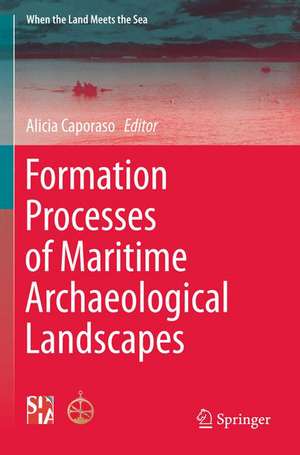Formation Processes of Maritime Archaeological Landscapes: When the Land Meets the Sea
Editat de Alicia Caporasoen Limba Engleză Paperback – 30 mai 2018
This edited volume presents a global perspective of current research in maritime archaeological landscape formation processes. In addition to “classically” considered submerged material culture and geography, or those that can be accessed by traditional underwater methodology, case studies include less-often considered sites and landscapes. Theselandscapes, for example, require archaeologists to use geophysical marine survey equipment to characterize extensive areas of the seafloor or go above the surface to access maritime archaeological resources that have received less scholarly attention.
| Toate formatele și edițiile | Preț | Express |
|---|---|---|
| Paperback (1) | 467.93 lei 6-8 săpt. | |
| Springer International Publishing – 30 mai 2018 | 467.93 lei 6-8 săpt. | |
| Hardback (1) | 729.68 lei 6-8 săpt. | |
| Springer International Publishing – 12 ian 2017 | 729.68 lei 6-8 săpt. |
Preț: 467.93 lei
Preț vechi: 550.50 lei
-15% Nou
Puncte Express: 702
Preț estimativ în valută:
89.53€ • 93.49$ • 73.94£
89.53€ • 93.49$ • 73.94£
Carte tipărită la comandă
Livrare economică 15-29 aprilie
Preluare comenzi: 021 569.72.76
Specificații
ISBN-13: 9783319931814
ISBN-10: 3319931814
Pagini: 220
Ilustrații: XII, 220 p. 52 illus., 32 illus. in color.
Dimensiuni: 155 x 235 mm
Greutate: 0.33 kg
Ediția:1st ed. 2017
Editura: Springer International Publishing
Colecția Springer
Seria When the Land Meets the Sea
Locul publicării:Cham, Switzerland
ISBN-10: 3319931814
Pagini: 220
Ilustrații: XII, 220 p. 52 illus., 32 illus. in color.
Dimensiuni: 155 x 235 mm
Greutate: 0.33 kg
Ediția:1st ed. 2017
Editura: Springer International Publishing
Colecția Springer
Seria When the Land Meets the Sea
Locul publicării:Cham, Switzerland
Cuprins
Introduction.- Chapter 1 : A Dynamic Processual Maritime Archaeological Landscape Formation Model.- Chapter 2: Mapping the Coastal Frontier: Shipwrecks and the Cultural Landscape of the Early Republic Littoral.- Chapter 3: Collaboration, Collision and (Re)conciliation: Indigenous Participation in Australia’s Maritime Industry—A Case Study from Point Pearce/Burgiyana, South Australia.- Chapter 4: The Formation of a West African Maritime Seascape: Atlantic Trade, Shipwrecks, and Formation Processes on the Coast of Ghana.- Chapter 5: Environment and Agency in the Formation of the Eastern Ship Graveyard in the Central Basin at Thonis-Heracleion, Egypt.- Chapter 6: Tsunami and Salvage: The Archaeological Landscape of the Beeswax Wreck, Oregon, USA.- Chapter 7: Coastal Erosion and Archaeological Site Formation Processes on Santa Rosa Island, California.- Chapter 8: Formation Processes of Maritime Archaeological Sites in Guadeloupe and the French West Indies: A First Approach.- Chapter 9:Conclusions/Discussion.
Recenzii
“Caporaso’s study of the Formation Processes of Maritime Archaeological of Landscapes presents an excellent perspective of current research in maritime archaeological landscape formation processes.” (Jacob Bart Hak, The Northern Mariner, cnrs-scrn.org, Vol. 30 (1), 2020)
“Formation Processes of Maritime Archaeological Landscapes is an important new exploration of the ever-widening approaches available to maritime archaeologists interested in conceptualizing and characterizing landscapes and seascapes. … this volume represents a significant step forward in communicating the complex and dynamic themes that are open for scholarly inquiry in landscape research.” (Nathan Richards, Journal of Maritime Archaeology, Vol. 14, 2019)
Notă biografică
Dr. Alicia Caporaso has been a professional archaeologist for 12 years as an instructor of Archaeology, Cultural Anthropology, and Oceanography, and as a federal archaeologist with the National Park Service and the Bureau of Ocean Energy Management. Her publications and book reviews have appeared in The ACUA Underwater Proceedings, Le Journal, The Nebraska Anthropologist, The Northern Mariner, South Dakota History, and Technical Briefs in Historical Archaeology.
Textul de pe ultima copertă
Research into the anthropogenic and taphonomic processes that affect the formation of maritime archaeological resources has grown significantly over the last decade in both theory and the analysis of specific sites and associated material culture. The addition of interdisciplinary inquiry, investigative techniques, and analytical modeling, from fields such as engineering, oceanography, and marine biology have increased our ability to trace the unique pathways through which archaeological sites progress from initial deposition to the present, yet can also link individual sites into an integrated socio-environmental maritime landscape.
This edited volume presents a global perspective of current research in maritime archaeological landscape formation processes. In addition to “classically” considered submerged material culture and geography, or those that can be accessed by traditional underwater methodology, case studies include less-often considered sites and landscapes. Theselandscapes, for example, require archaeologists to use geophysical marine survey equipment to characterize extensive areas of the seafloor or go above the surface to access maritime archaeological resources that have received less scholarly attention.
This edited volume presents a global perspective of current research in maritime archaeological landscape formation processes. In addition to “classically” considered submerged material culture and geography, or those that can be accessed by traditional underwater methodology, case studies include less-often considered sites and landscapes. Theselandscapes, for example, require archaeologists to use geophysical marine survey equipment to characterize extensive areas of the seafloor or go above the surface to access maritime archaeological resources that have received less scholarly attention.
Caracteristici
Presents a new approach to integrating the components of the maritime landscape with the understanding of the archaeological and historic records Examining subject with an interdisciplinary and international viewpoint Brings together topics such as active coastal erosion, preservation of archaeological sites, formation of site stratigraphy, location of archaeological deposits, topography, and changes in resource distribution Includes supplementary material: sn.pub/extras





